Friday, October 30, 2009
Ant Chat Episode 16: Lasius claviger Nuptial Flight
Show Notes
It's fall time and while most ants are done their mating cycles for the year some Lasius species are still going strong. I explain what a social parasite is and why Lasius niger (pronounced nyjer) group species are so important.
Lasius claviger, formerly Acanthomyops genus.
http://antbase.org/ants/publications/3514/3514.pdf
Wing, M. W. (1968) Taxonomic Revision of the Nearctic Genus Acanthomyops (Hymenoptera: Formicidae) Memoirs of the Cornell University Agricultural Experiment Station, 405, 1-173
Their aphid farming segways into other foraging habits at this time of year. Sunflowers are a fair plant to view this foraging behavior on, they offer a lot in the way of seeds, sap and caterpillars. Plus they're good for the birds.
And lastly I talk about a 3D Plaster Setup I made.
Goldenrod
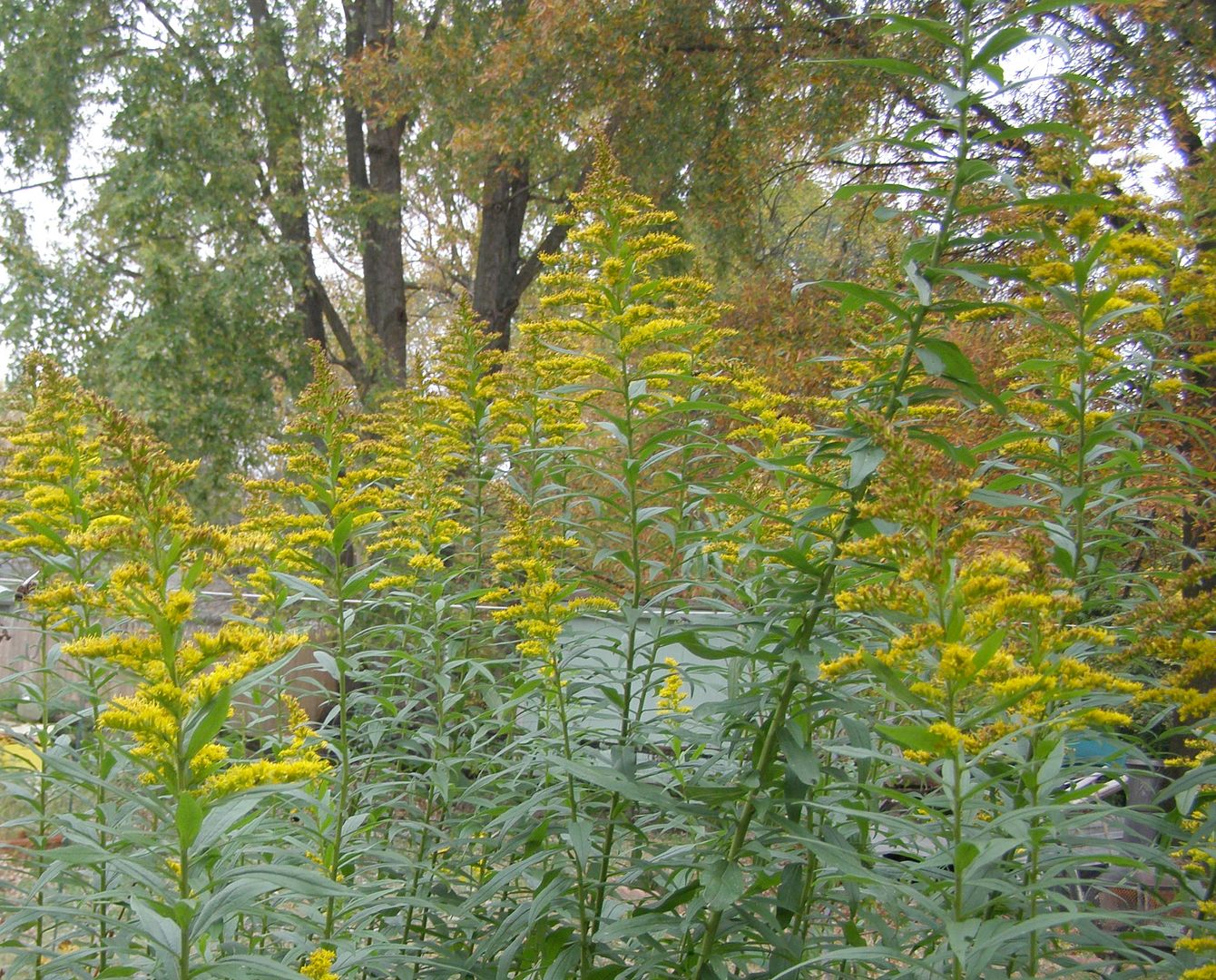
What is very likely Late Goldenrod, Solidago gigantea, has been blooming out in the yard for a few weeks now. Solidago species support the highest number of Lepidoptera species of any perennial, (note that most native trees support a lot more,) and sure enough they have gotten a fair amount of activity.
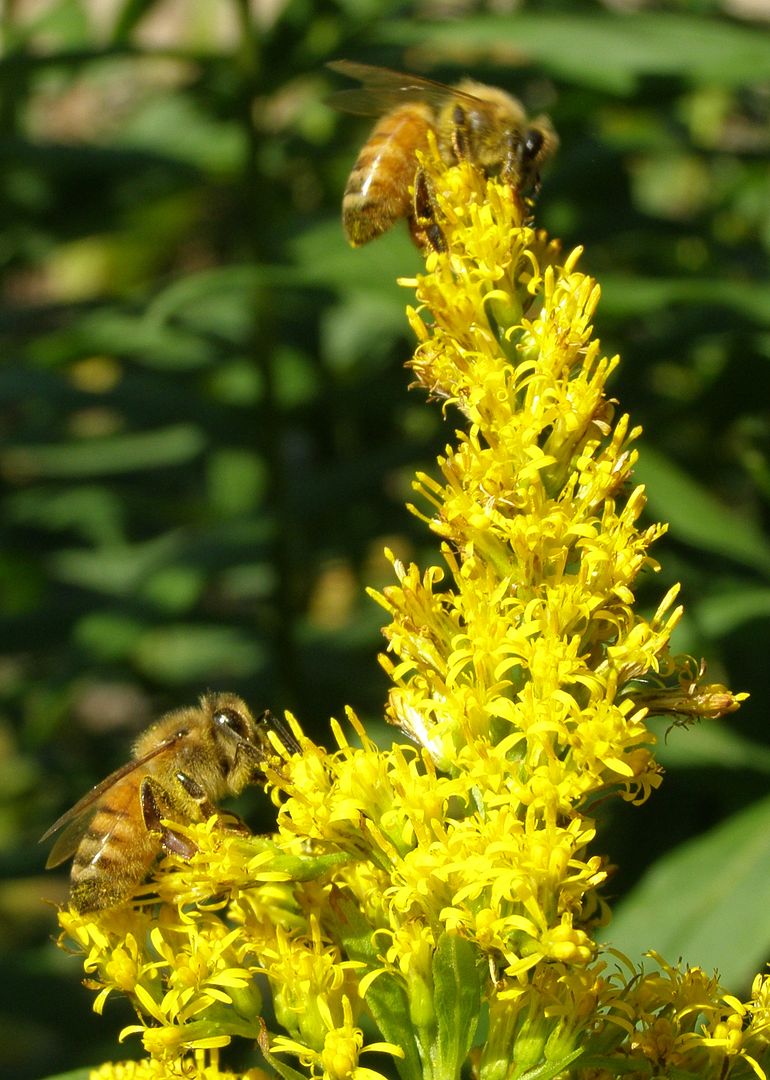
Because it's at the height of flowering in October-November it's just about the only decent source of nectar for pollinating insects. Few Asters last this late in the season.
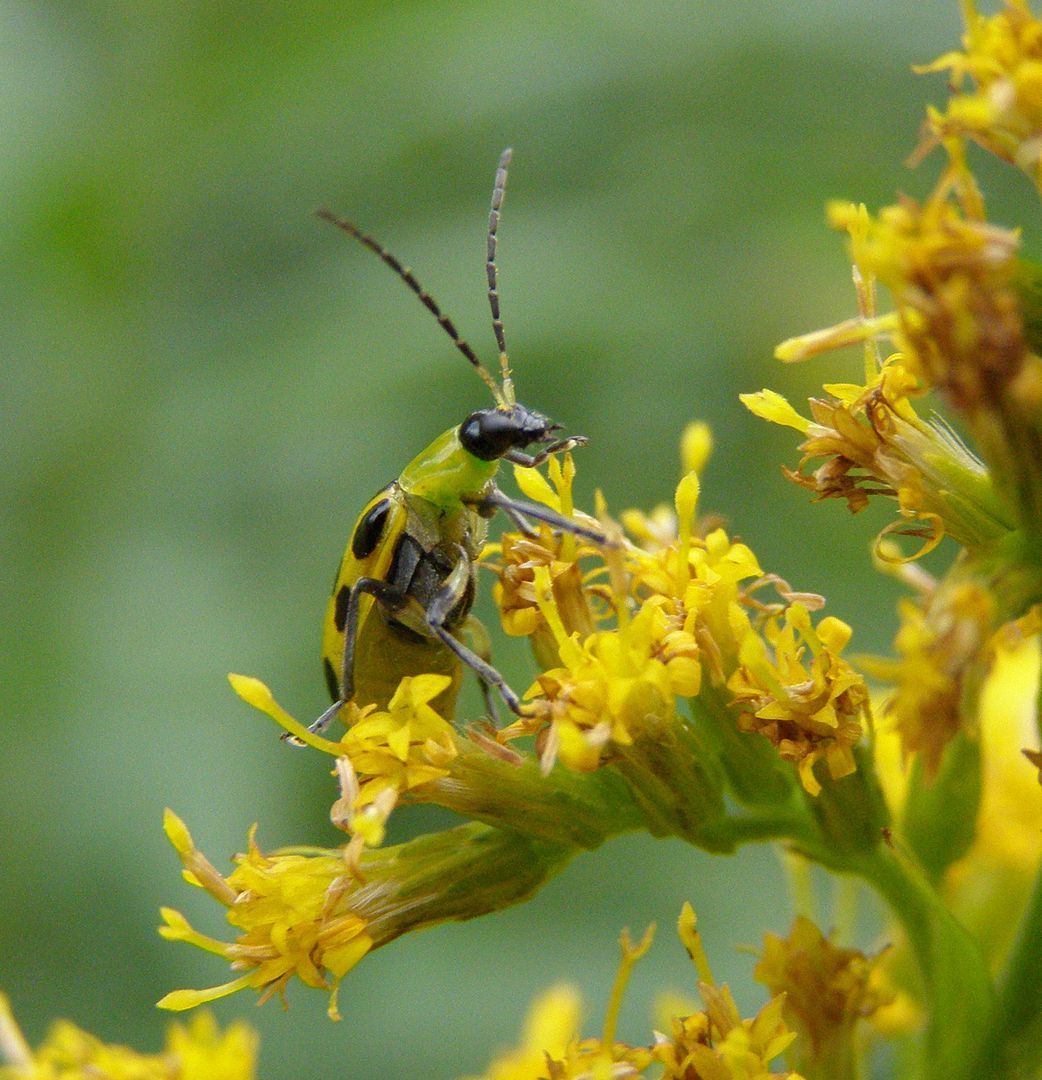
What I believe is Diabrotica undecimpunctata, The Eastern Spotted Cucumber Beetle spent it's time sipping at the flowers, but probably also nibbled some of the leaves. They can be a major pest for assorted field crops (Corn, Cucumber, Potatoes, etc...) but I'm not worried.
For those of you who hate this bug, note that they over winter in the adult stage and killing them is an option. But I have to say making your yard more bird friendly can work even better.
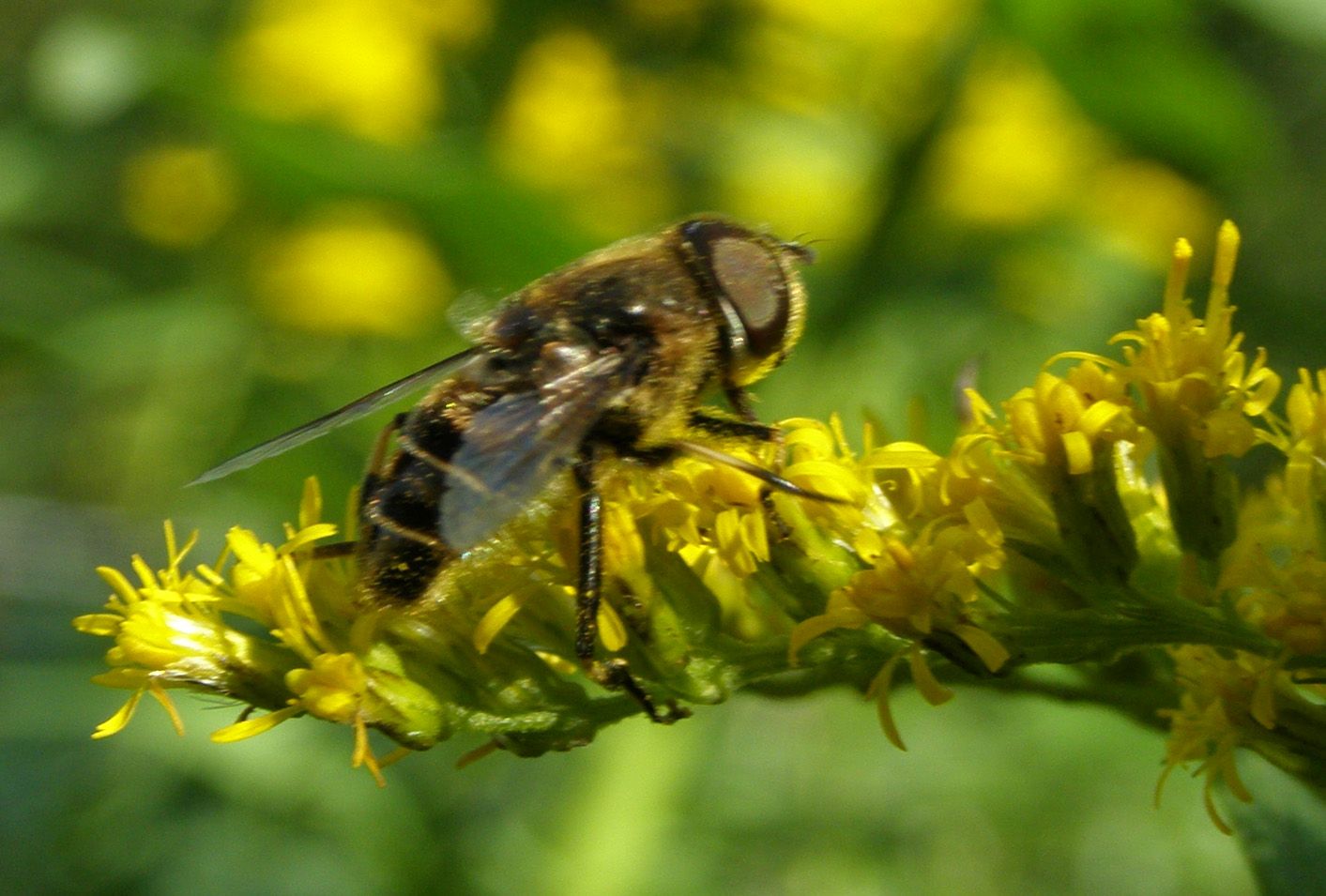
Flower flies mimic bees to avoid being eaten by birds. This one is doing a fairly bad job though but I have seen some that were nearly spot on.
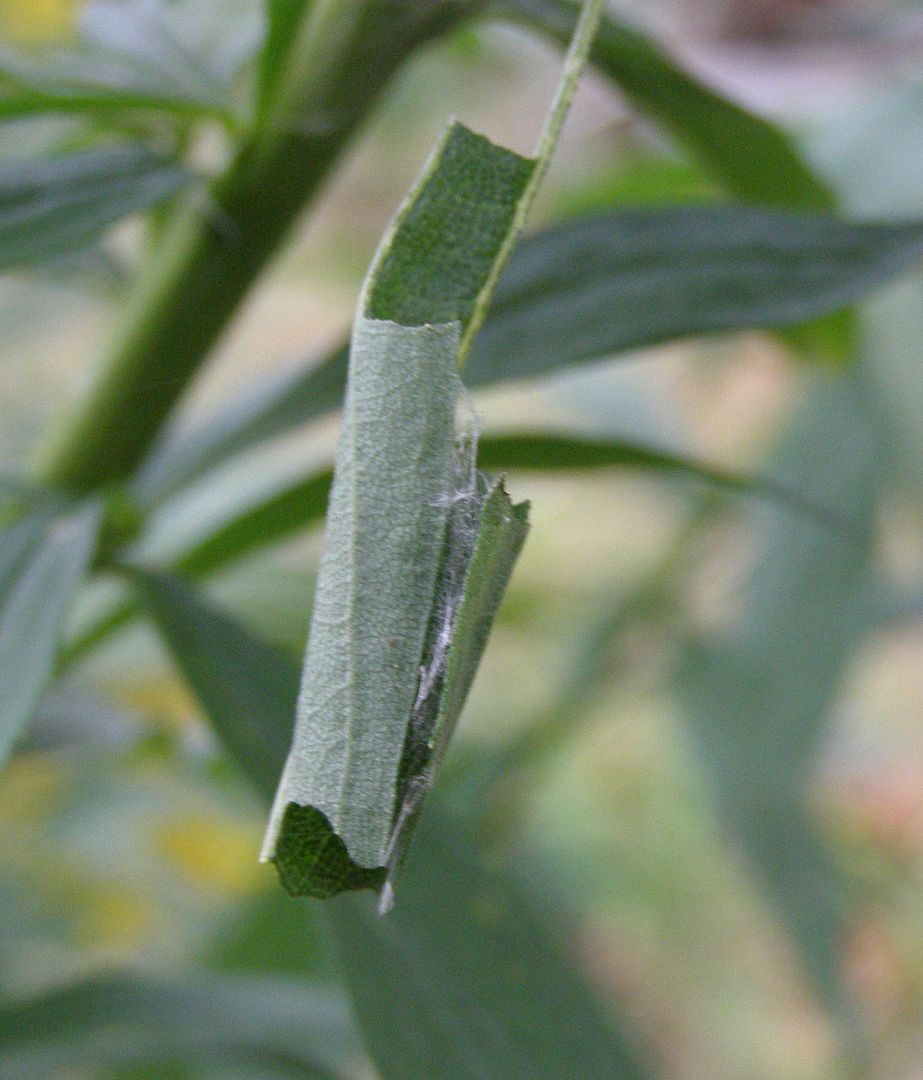
Some of the leaves have been coiled up in to "caterpillar sheds" which protect the caterpillar during the day. These don't last very long though as the caterpillar eventually eats the leaf to an unusable state.

Inside you can sort of make out the caterpillar.
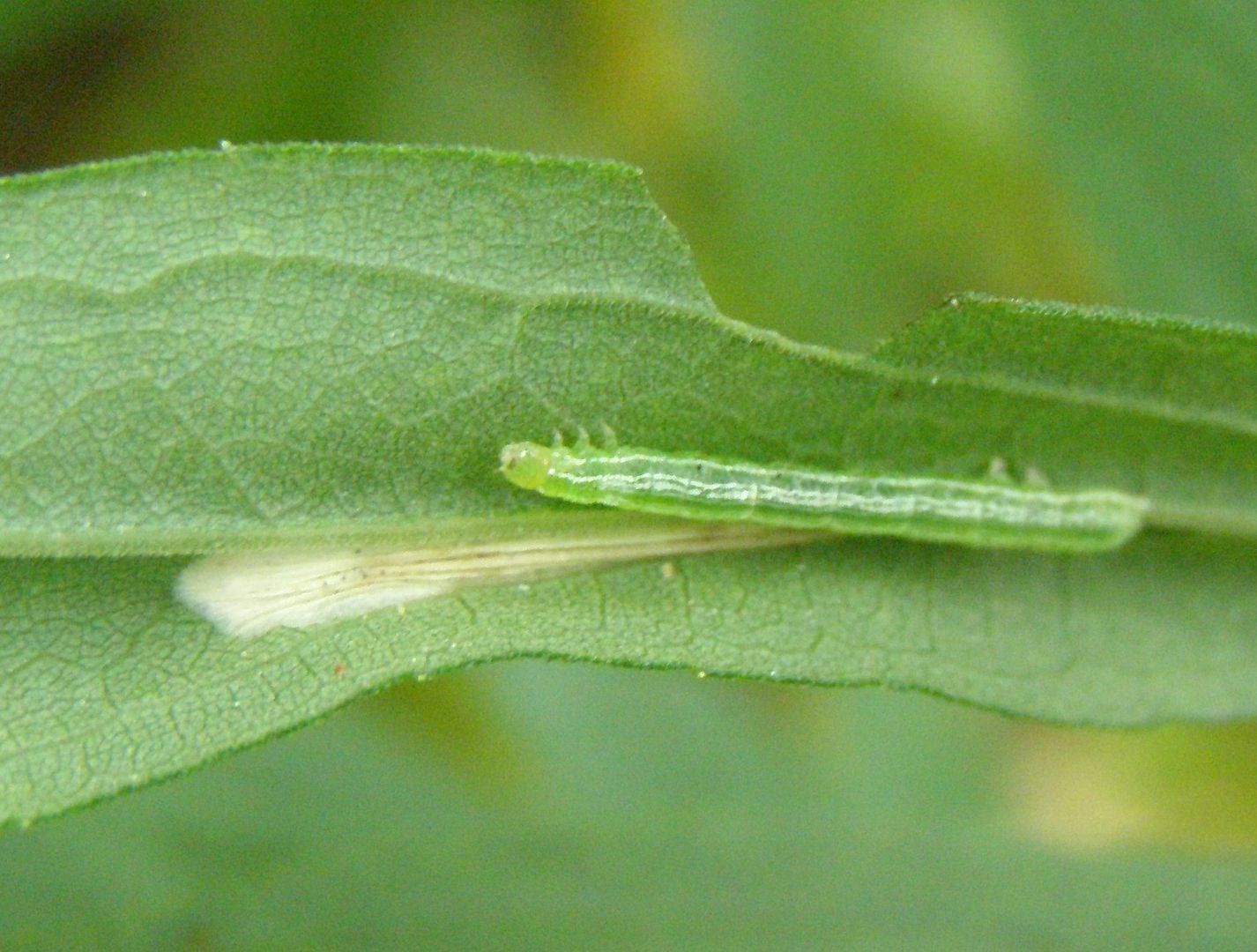
On a nearby plant a different species of caterpillar employs a similar strategy. This one was on the Rudbeckia, (basically a Black Eyed Susan without a common name,) and had the leaf kinked so it was hard to spot from under the leaf. I had to unfold it some for the photo.
Thursday, October 29, 2009
Exploding Impatiens
My new favorite thing to do out in the garden ever since I learned we bought Exploding Impatiens. In years past I never realized this happening at all. I occasionally found new plants growing but not a whole lot. This year though we bought a colorful batch from a wholesale nursery a half hour away and wow. The seed pods expand and eventually explode either from being disturbed, or drying out on the plant. The Seeds are sent flying about, most land near the plant but some are shot off several feet away I'm sure. I've collected seeds and hopefully this will save me a few bucks from having to buy a new flat of these annuals next year.
Wednesday, October 28, 2009
Butterfly Life Cycle - Pipevine Swallowtail
I'm posting this video as a winter time reminder. Many butterflies and moths over winter in the crystals stage, often times they're still attached to the host plant. It's best to wait until late March or April before clearing up the garden to help these caterpillars survive. You may find you'll have more early butterflies that way.
This is also part of a good time-lap series. Other videos from the author are also worth watching.
Monday, October 26, 2009
Fall Planting
Probably not what most gardeners are expecting. I'm refuse to plant tulips, crocuses, daffodils and so on. Next year I might make an exception for our native hyacinths, Camassia angusta, but that gets two feet tall. No I won't be planting anymore of those European imports. I'm still planting in preparation for next year but it's more to get the roots established. During the winter the root system of most plants still grows. In fact some plants like garlic are growing green and happy in below freezing weather, not to mention all the evergreens out there. So here is a list of plants in the new garden I put in.
First though let me state most of the plants came from www.prairiemoon.com and I'm very happy with their selection of plants. The only failing I've had with them so far has been with the soil their plants come in. One of my plants came in a pot that had another plant obviously growing in it and still alive. Something called Crinkled Creeper (I know because the tag was still in the effing pot!) and as far as I can tell it's not native but also doesn't grow in my climate so we'll see how far it gets. Otherwise though they sell plants you just can't find anywhere else.
Solidago rugosa, Goldenrod, one of the shorter bushy varieties. I would have preferred a taller one, something higher then 4' but it will do I guess.
Chelone Glabra, White Turtle Head, I already have one of these planted and I was so interested by it that I decided to get 4 more. The Baltimore Checkerspot, Euphydryas phaeton, is my end goal here. It's a beautiful butterfly. Checkerspot butterflies in general are a colorful touch to anyone's garden.
Cassia hebecarpa, Wild Senna, a semi tropical looking plant. This produces extra-floral nectar to attract ants to feed on it. The hopefully, but not always protect the plants from the Cloudless sulphur, Phoebis sennae, an all yellow butterfly I'm reasonable sure I've seen flying through my yard. What's neat is the cocoons they form looks just like one of the flowers on the plant.
Lupinus perennis, no common name I'm familiar with. A native Lupin that is the host plant to a Blue butterfly. The caterpillars of which over winter inside the nests of ants, feeding on their brood and emerging from the nest in spring like a nuptial flight. This group of butterflies is on the decline and hopefully these plants will survive. I think my soil is a bit to clay like for them.
Eryngium yuccifolium, a very odd looking grassy plant that blooms a cluster of white ball-like nut. Similar to Sea Holly but white. I'm told bees really go for the nectar.
Amorpha canescens, Lead Plant, (Lead as in the metal) another plant I'm going for pollinators. Also I think it really looks neat. It's native to the US but not the east coast. Still grows in this zone though so hopefully I'll see it bloom nicely next year. Lots and lots of little purple flowers with bright orange stamens sticking out.
Silene regia, Royal Catchfly, a medium sized plant with bright red tube like flowers. I'm told perfect for hummingbirds and hopefully I'll get to see some. There's a native honeysuckle planted right near them. Royal Catchfly is a semi-carnivorous plant. Insects get stuck to parts of it like a sundew but it's not needed for the plant to survive.
Filipendula rubra, Queen of the Prairie, easily the gayest plant I've ever seen. 9 foot tall stem leading up to a pink cluster of tiny flowers often forming a heart shape. I'm planting it because it vaguely reminds me of Joe Pye Weed and I really want to know what on earth pollinates this giant ball of cotton candy! I'm not put off by the "gayness" as I describe it but it's not a plant I want to have to much of. Could send the wrong signals. (Watch it turn out to be the best honey plant in the yard.)
Antennaria neglecta, Prairie Pussytoes, easily one of the gayest common names I've ever herd. This is one of those early blooming plants important for early flying insects. It's one of the host plants to the American Painted Lady butterfly too. It's also low growing that it can be planted in the lawn, assuming the grasses you have aren't aggressive growers.
Cornus alternifolia, Alternate-leaf Dogwood. Before the addition was put on our house we had a beautiful pink flowering dogwood tree. For unknown reasons though my dad decided to chop it down, even though the construction of the house had nothing to do with this tree. So I've planted a new dogwood near about where it was planted. I would have gone with Cornus florida but there is an introduced blight killing those trees sadly. Whole branches of the tree just go dead one year and it slowly spreads to other limbs as the tree gets older. Cornus alternifolia I think is unaffected by this so hopefully it will do well. Not so much a tree though as it is a bush on par with viburnums. Supports lots of caterpillar life as well birds too.
Lindera benzoin, Spice Bush, I bought two of these. Another all around good plant. If I have a male and female then one will have berries on it. Berry plants are always pretty to look at with snow on them in the winter. This also the host plant to the Spice Bush Swallowtail, Papilio troilus. The caterpillar mimics a snake (one that's 3 inches long but a snake all the same) even going as far to flicker it's antenna like a tongue.
Caltha palustris, Marsh Marigold, I'll be honest by now I was running out of room. So these went in the front garden. I'm hoping they'll tolerate mostly shade. Another early blooming plant I see from images online that they grow well in water.
Hepatica acutiloba, Sharp-lobed Hepatica. Another early blooming plant. I don't expect it to bloom though until the next spring. A variety of Hepatica I planted last year only produced a leaf and it's kept it all year. I'm told this leaf will die back and make way for a flower followed by another group of leaves and they'll spread from there. What's neat about these is they're distributed by ants. They make seeds with elaiosome on them and the ants bring that back to the nest (assuming the ant is the right size compared to the seed).
Can't wait for next year.
First though let me state most of the plants came from www.prairiemoon.com and I'm very happy with their selection of plants. The only failing I've had with them so far has been with the soil their plants come in. One of my plants came in a pot that had another plant obviously growing in it and still alive. Something called Crinkled Creeper (I know because the tag was still in the effing pot!) and as far as I can tell it's not native but also doesn't grow in my climate so we'll see how far it gets. Otherwise though they sell plants you just can't find anywhere else.
Solidago rugosa, Goldenrod, one of the shorter bushy varieties. I would have preferred a taller one, something higher then 4' but it will do I guess.
Chelone Glabra, White Turtle Head, I already have one of these planted and I was so interested by it that I decided to get 4 more. The Baltimore Checkerspot, Euphydryas phaeton, is my end goal here. It's a beautiful butterfly. Checkerspot butterflies in general are a colorful touch to anyone's garden.
Cassia hebecarpa, Wild Senna, a semi tropical looking plant. This produces extra-floral nectar to attract ants to feed on it. The hopefully, but not always protect the plants from the Cloudless sulphur, Phoebis sennae, an all yellow butterfly I'm reasonable sure I've seen flying through my yard. What's neat is the cocoons they form looks just like one of the flowers on the plant.
Lupinus perennis, no common name I'm familiar with. A native Lupin that is the host plant to a Blue butterfly. The caterpillars of which over winter inside the nests of ants, feeding on their brood and emerging from the nest in spring like a nuptial flight. This group of butterflies is on the decline and hopefully these plants will survive. I think my soil is a bit to clay like for them.
Eryngium yuccifolium, a very odd looking grassy plant that blooms a cluster of white ball-like nut. Similar to Sea Holly but white. I'm told bees really go for the nectar.
Amorpha canescens, Lead Plant, (Lead as in the metal) another plant I'm going for pollinators. Also I think it really looks neat. It's native to the US but not the east coast. Still grows in this zone though so hopefully I'll see it bloom nicely next year. Lots and lots of little purple flowers with bright orange stamens sticking out.
Silene regia, Royal Catchfly, a medium sized plant with bright red tube like flowers. I'm told perfect for hummingbirds and hopefully I'll get to see some. There's a native honeysuckle planted right near them. Royal Catchfly is a semi-carnivorous plant. Insects get stuck to parts of it like a sundew but it's not needed for the plant to survive.
Filipendula rubra, Queen of the Prairie, easily the gayest plant I've ever seen. 9 foot tall stem leading up to a pink cluster of tiny flowers often forming a heart shape. I'm planting it because it vaguely reminds me of Joe Pye Weed and I really want to know what on earth pollinates this giant ball of cotton candy! I'm not put off by the "gayness" as I describe it but it's not a plant I want to have to much of. Could send the wrong signals. (Watch it turn out to be the best honey plant in the yard.)
Antennaria neglecta, Prairie Pussytoes, easily one of the gayest common names I've ever herd. This is one of those early blooming plants important for early flying insects. It's one of the host plants to the American Painted Lady butterfly too. It's also low growing that it can be planted in the lawn, assuming the grasses you have aren't aggressive growers.
Cornus alternifolia, Alternate-leaf Dogwood. Before the addition was put on our house we had a beautiful pink flowering dogwood tree. For unknown reasons though my dad decided to chop it down, even though the construction of the house had nothing to do with this tree. So I've planted a new dogwood near about where it was planted. I would have gone with Cornus florida but there is an introduced blight killing those trees sadly. Whole branches of the tree just go dead one year and it slowly spreads to other limbs as the tree gets older. Cornus alternifolia I think is unaffected by this so hopefully it will do well. Not so much a tree though as it is a bush on par with viburnums. Supports lots of caterpillar life as well birds too.
Lindera benzoin, Spice Bush, I bought two of these. Another all around good plant. If I have a male and female then one will have berries on it. Berry plants are always pretty to look at with snow on them in the winter. This also the host plant to the Spice Bush Swallowtail, Papilio troilus. The caterpillar mimics a snake (one that's 3 inches long but a snake all the same) even going as far to flicker it's antenna like a tongue.
Caltha palustris, Marsh Marigold, I'll be honest by now I was running out of room. So these went in the front garden. I'm hoping they'll tolerate mostly shade. Another early blooming plant I see from images online that they grow well in water.
Hepatica acutiloba, Sharp-lobed Hepatica. Another early blooming plant. I don't expect it to bloom though until the next spring. A variety of Hepatica I planted last year only produced a leaf and it's kept it all year. I'm told this leaf will die back and make way for a flower followed by another group of leaves and they'll spread from there. What's neat about these is they're distributed by ants. They make seeds with elaiosome on them and the ants bring that back to the nest (assuming the ant is the right size compared to the seed).
Can't wait for next year.
Friday, October 23, 2009
Woolly Bears
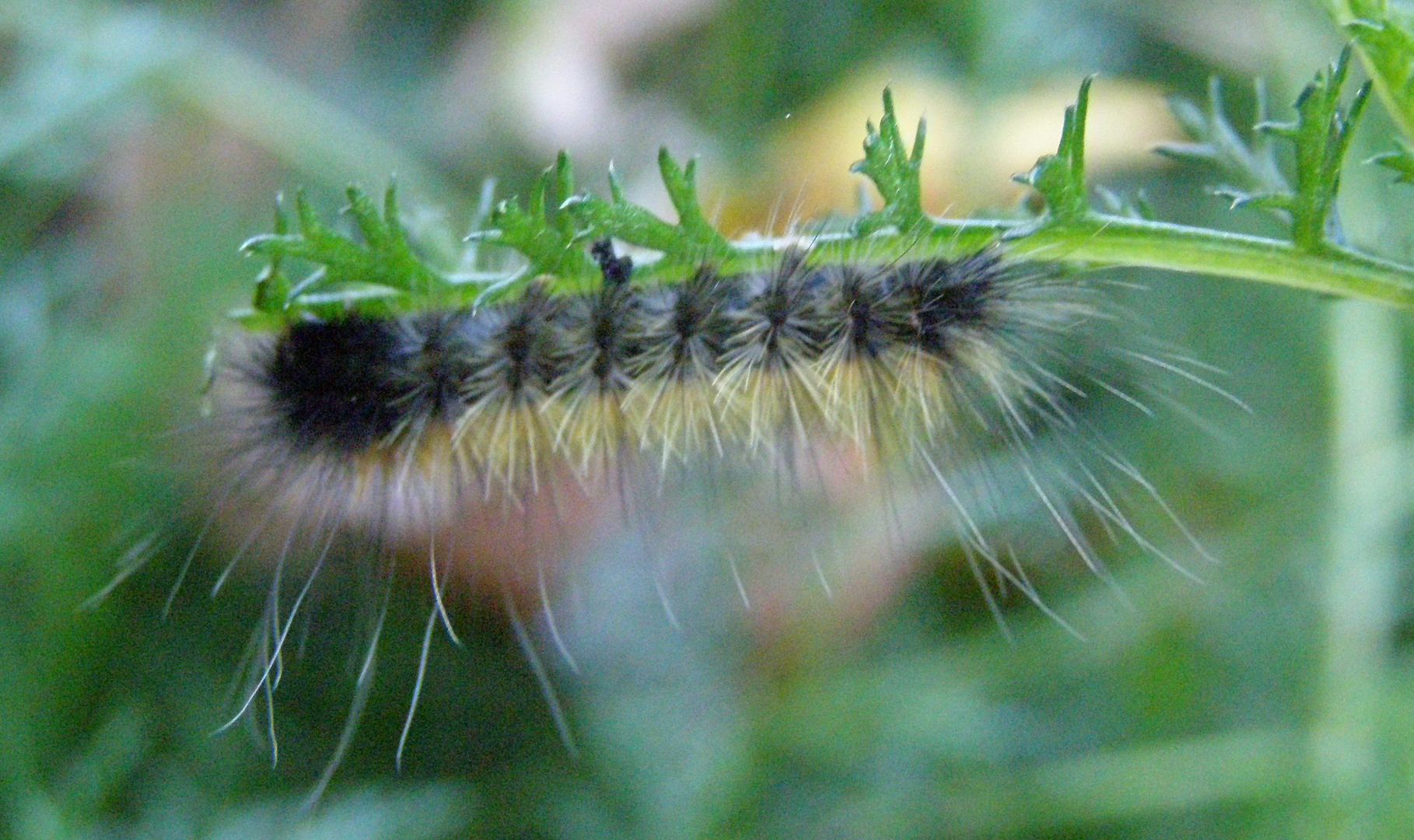
Well I'm seeing Woolly Bears so it must be fall. Pyrrharctia isabella is one of the most commonly encountered caterpillars at this time of year. Unlike many other species of Lepidoptera one doesn't have to have a butterfly garden nor the host plant to find them.
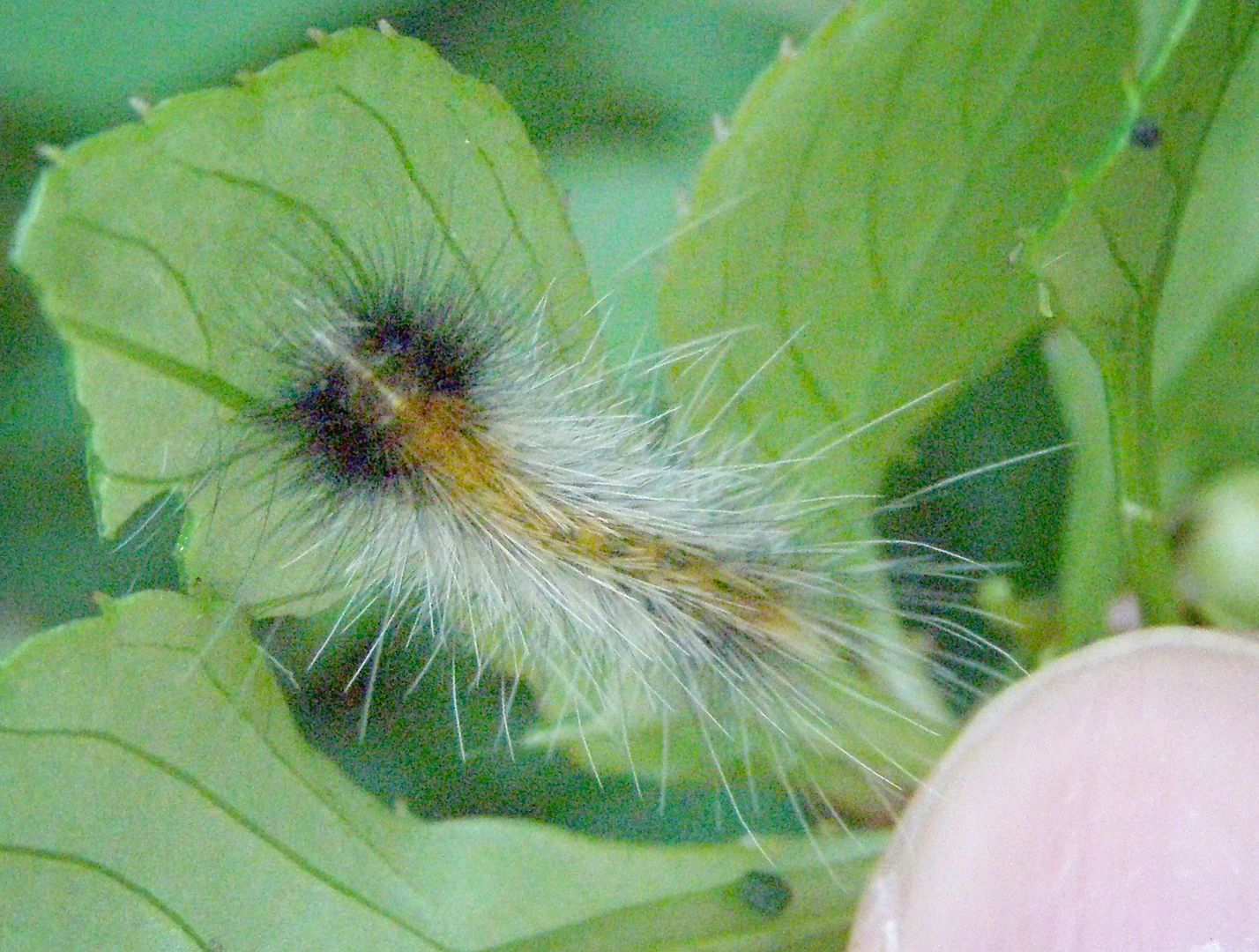
Here a young instar nibbles at the leaf of an Impatient. What makes them so common is that they can feed on almost any plant and constantly wonder feeding on a variety of plants as they go.
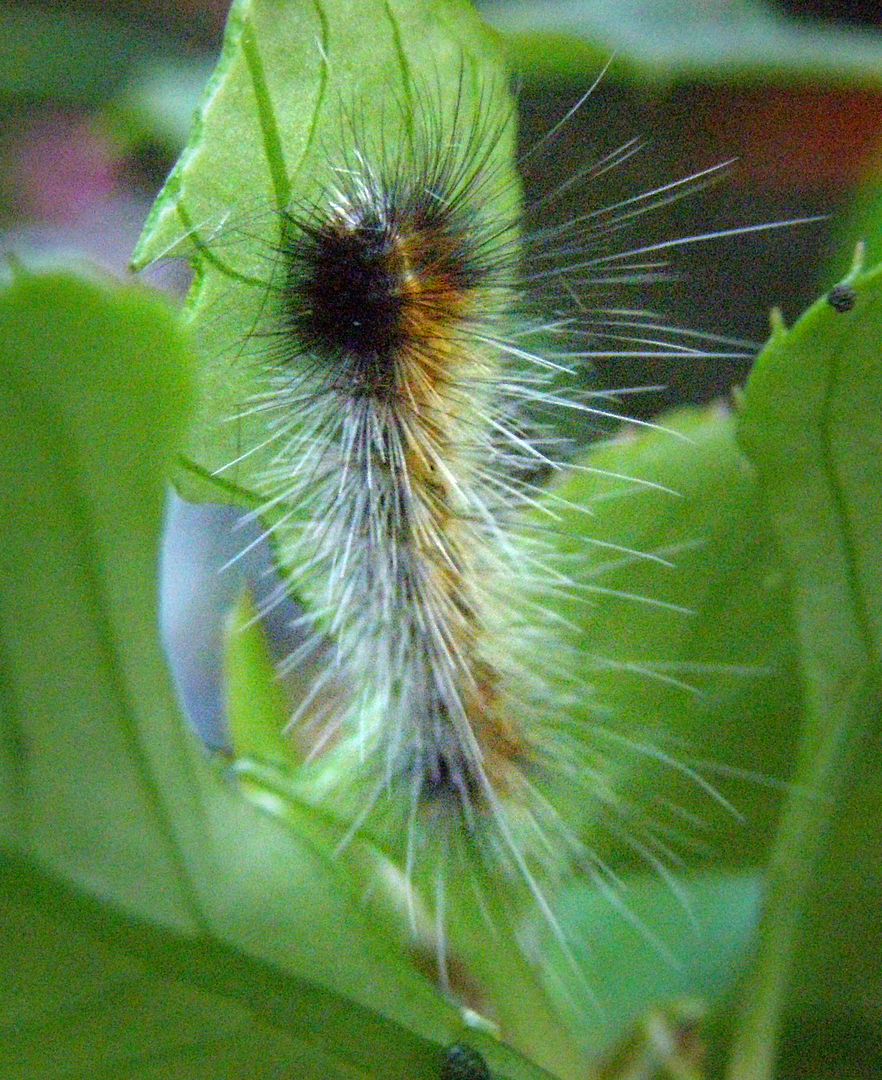
Caterpillars of Eastern North America: A Guide to Identification and Natural History (Princeton Field Guides)
In it they list a number of host plants that include "dandelion, grasses, lettuce, meadowsweet, and nettle" but I assure you those are just a drop in the bucket. BugGuide.net adds the following: asters, birches, clover, corn, elms, maples and sunflowers.
If I recall right I think they eat the leaves to apple, and cherry trees too but don't venture up very hight.
With so many "host plants" surely the moths must be attracted to one or the other and I'm very sure they are. I found a cluster of hatched eggs on my goldenrod (that I'm kicking myself for not photographing,) but these could belong to any number of insect. There is such a cluster visable though in the BugGuide.net link above.
Many have asked why do the caterpillars migrate at all, surely striping the leaves off the plant they were all hatched on would be the safest option. This is not quite the case though. Spreading out is a good tactic because birds will only discover individuals rather then clusters of food. Parasites will also have a harder time homing in on their hosts. Also the caterpillars become more or less toxic based on the certain plants that they eat.

Superstitious people like to believe that the longer the band of brown indicates a mild winter. Though this usually conflicts with the logic of groundhogs, migratory butterflies, the weather man, the width and density of patches of moss on north sides of trees, the other weather man, and even other Woolly Bear caterpillars.
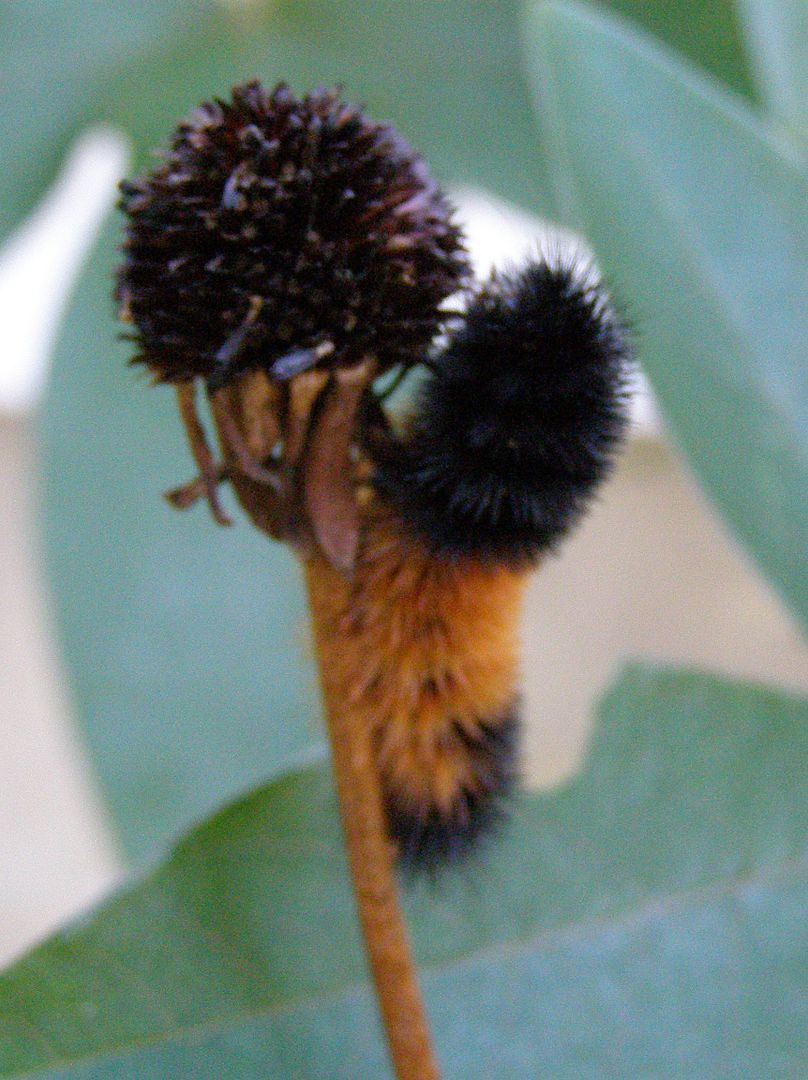
Walking just a few feet away I found another Woolly Bear that seemed to be in disagree.
Thursday, October 22, 2009
Very Brief, New Book(s)
I bought a bunch of new books earlier this week. Mostly murder mysteries that have nothing to do with the topics on this blog. (Agatha Christie if you're wondering.) But I also bought a book called "Gaia's Garden" by Toby Hemenway. I haven't started reading it yet but glanced through some pages and frowned. One of their lists is plants good for toilet paper and Trilliums are listed! HOW FUCKING DARE ANYONE DO THAT! On another list they recommend Tree of Heaven, one of the most god awful invasive plants I've ever seen!
In short I'm not looking forward to reading this book just from that alone. I will eventually get around to it though and post my feelings afterward.
In short I'm not looking forward to reading this book just from that alone. I will eventually get around to it though and post my feelings afterward.
Wednesday, October 21, 2009
Lasius claviger Nuptial Flight
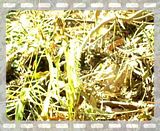
During the afternoon hours a storm of ants began pouring out of my compost pile. Lasius claviger is an ant usually know for nesting in soggy areas often under large stones. Though the grassy piles looks dead I assure you the interior is hot and soggy enough for many ants to nest.
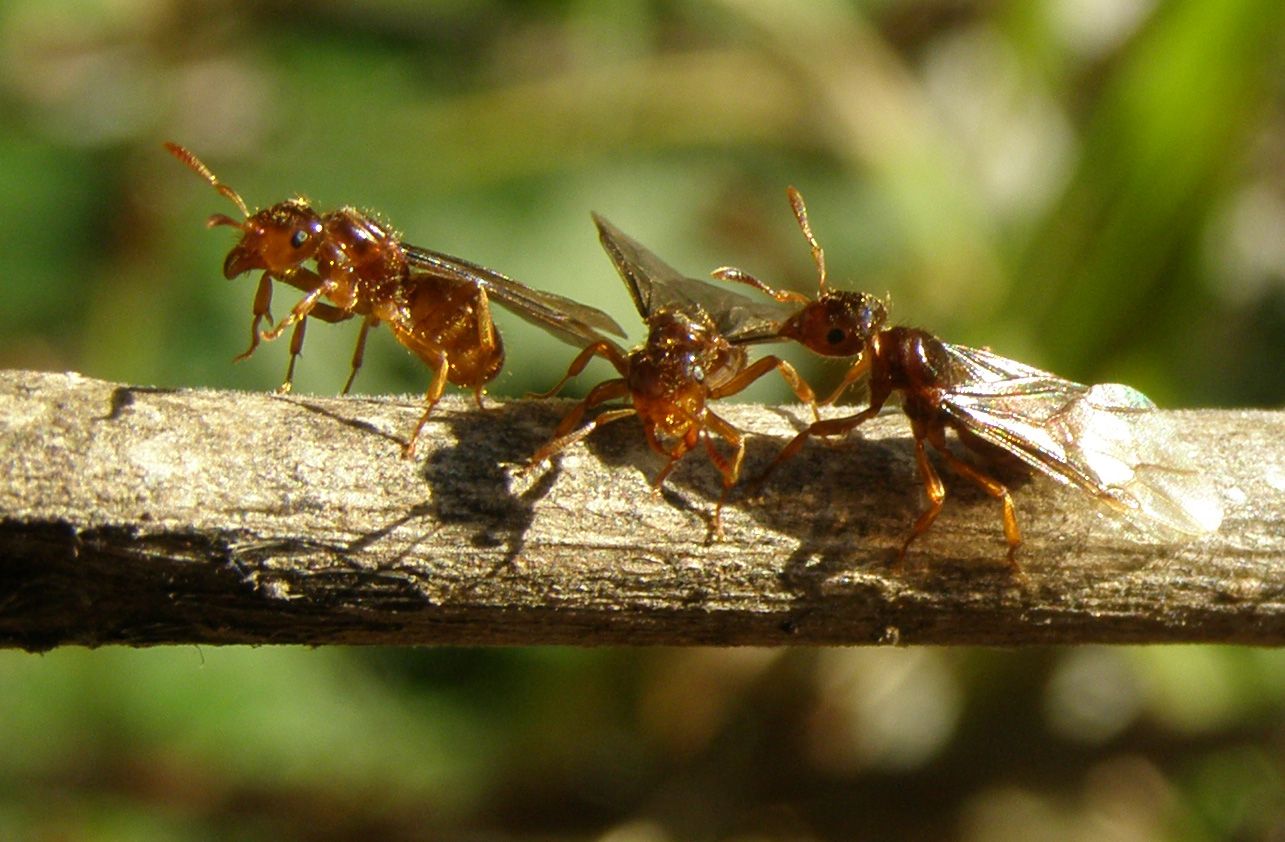
Tall stems of grass and various Rose of Sharon stems I've been weeding out became mobbed by queens, in many cases, crawling over one another to take off.


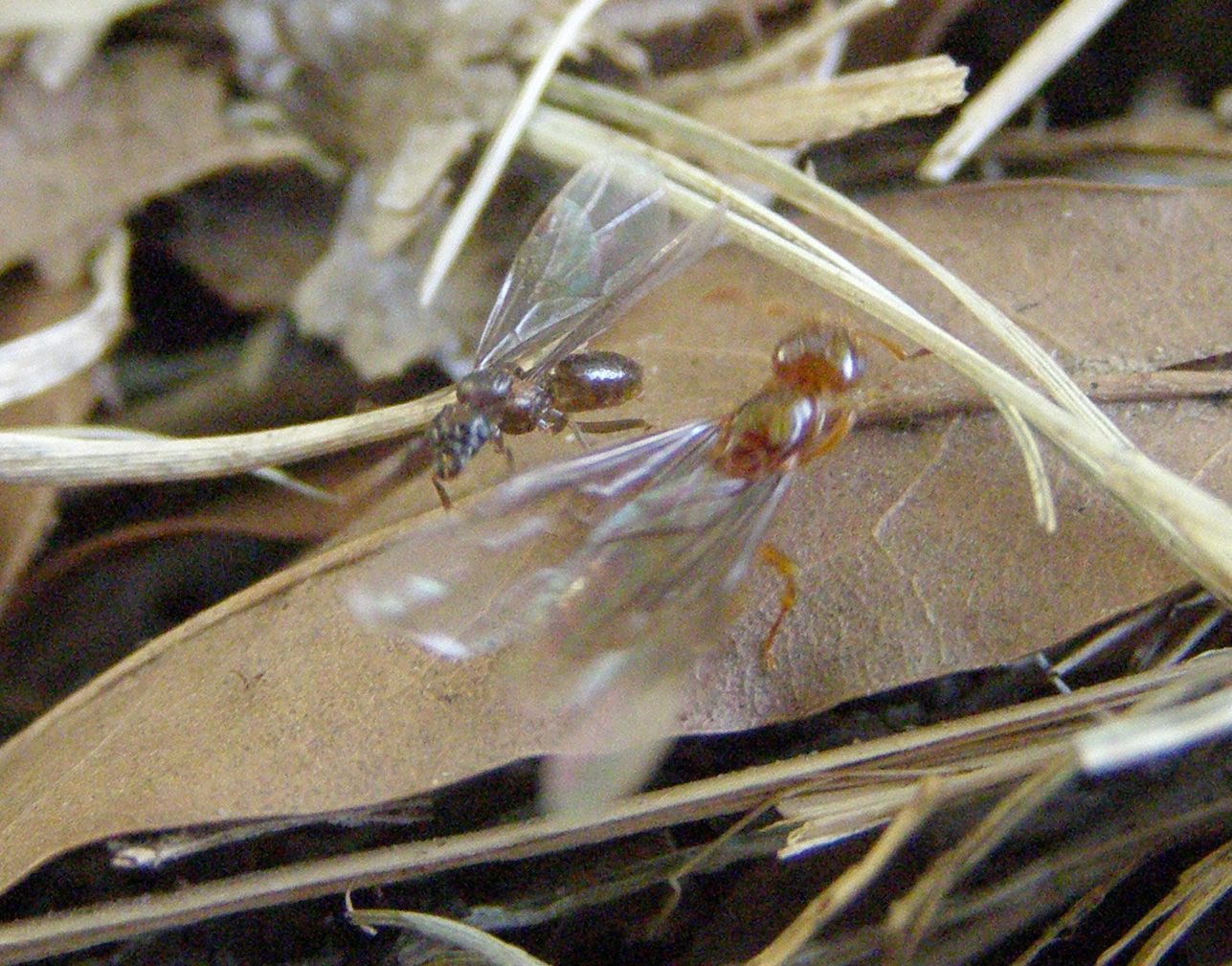
A good size comparison between a male (left) and queen (right). Regardless of the color of the ant more often then not male ants tend to be black in color with few exceptions. Though they have met down here on the ground mating is strictly done up in the air. In this colony males were even sent out through a different entrance and several hours before the queens started emerging. This ensures that inbreeding is kept to a minimum.
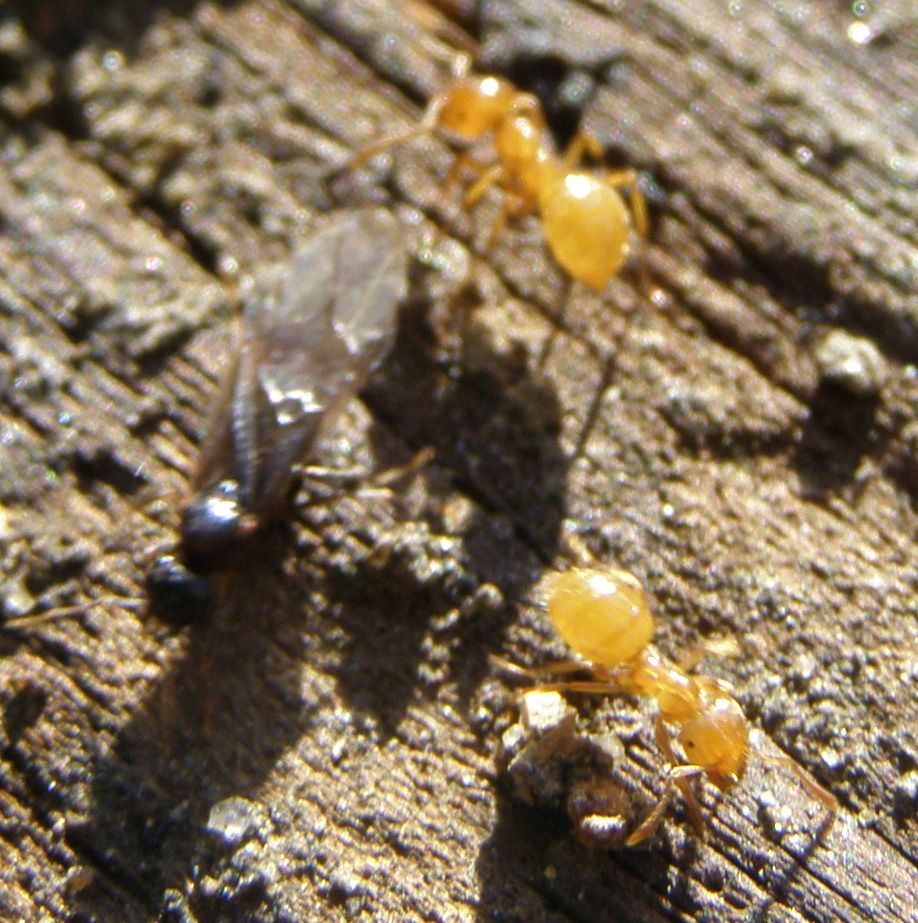
Workers are slightly smaller if not the same size, but again we see how little color matters between castes. "Yellow" colored workers is a general term that covers a range of colors. Ant colors are often hard to describe so generalizing Yellow, Red/Brown, and Black are best. (There is also Green but not in North America.) Yellow workers is often a sign of a nocturnal forager and or a subterranean forager. Lasius claviger is a subterranean forager that feeds almost exclusively on dew producing root aphids.
Lasius claviger Hanging Out

Well there was another nuptial flight today and once again my Goldenrod plants had queens purchased. They weren't doing much of anything, just standing still. A Myrmecologiest I know suggested they might have Summit Disease. The study posted talks about a different species, Formica rufa, but there are a number of diseases out there that take advantage of certain groups of ants. So maybe something similar is at work here.
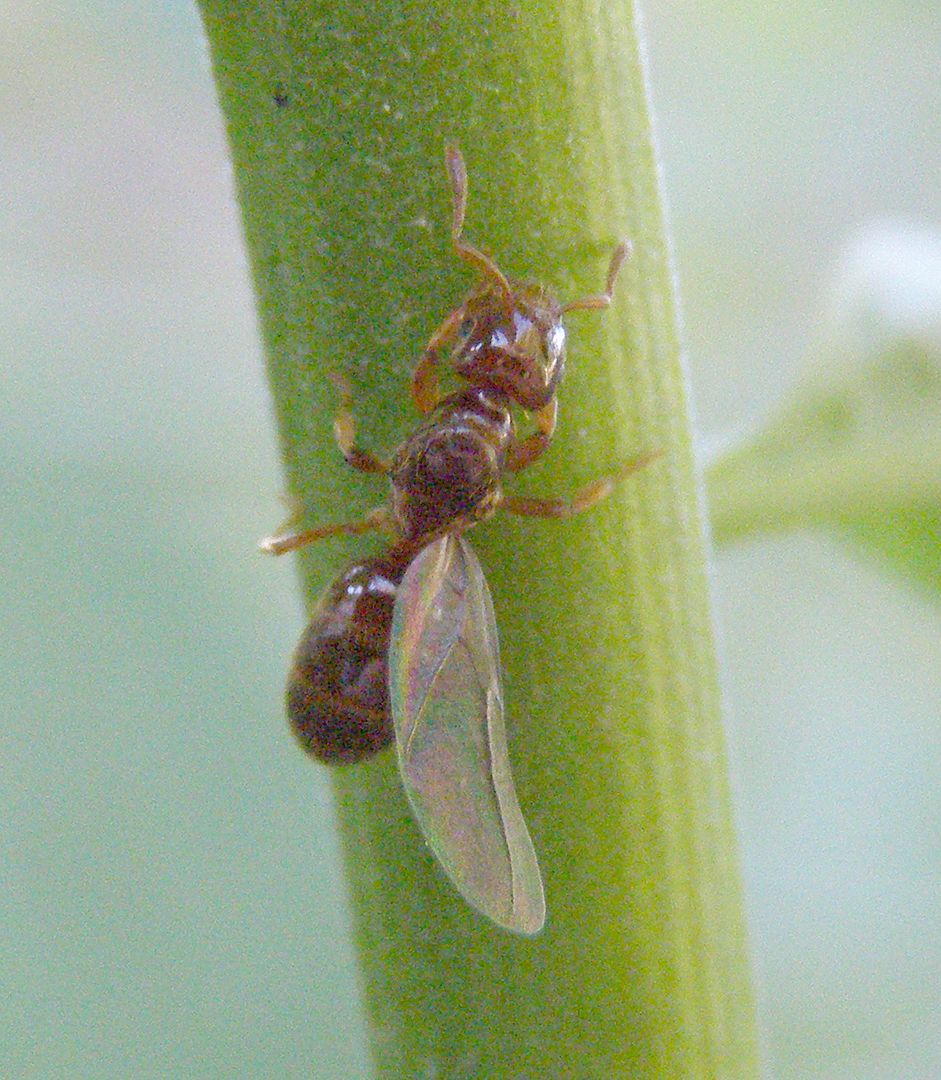
This one didn't even bother to remove her other wing. She just laid there motionless but still clearly alive. The only thing I can think of is that maybe they hang around on tall plants to warm up in the early morning.
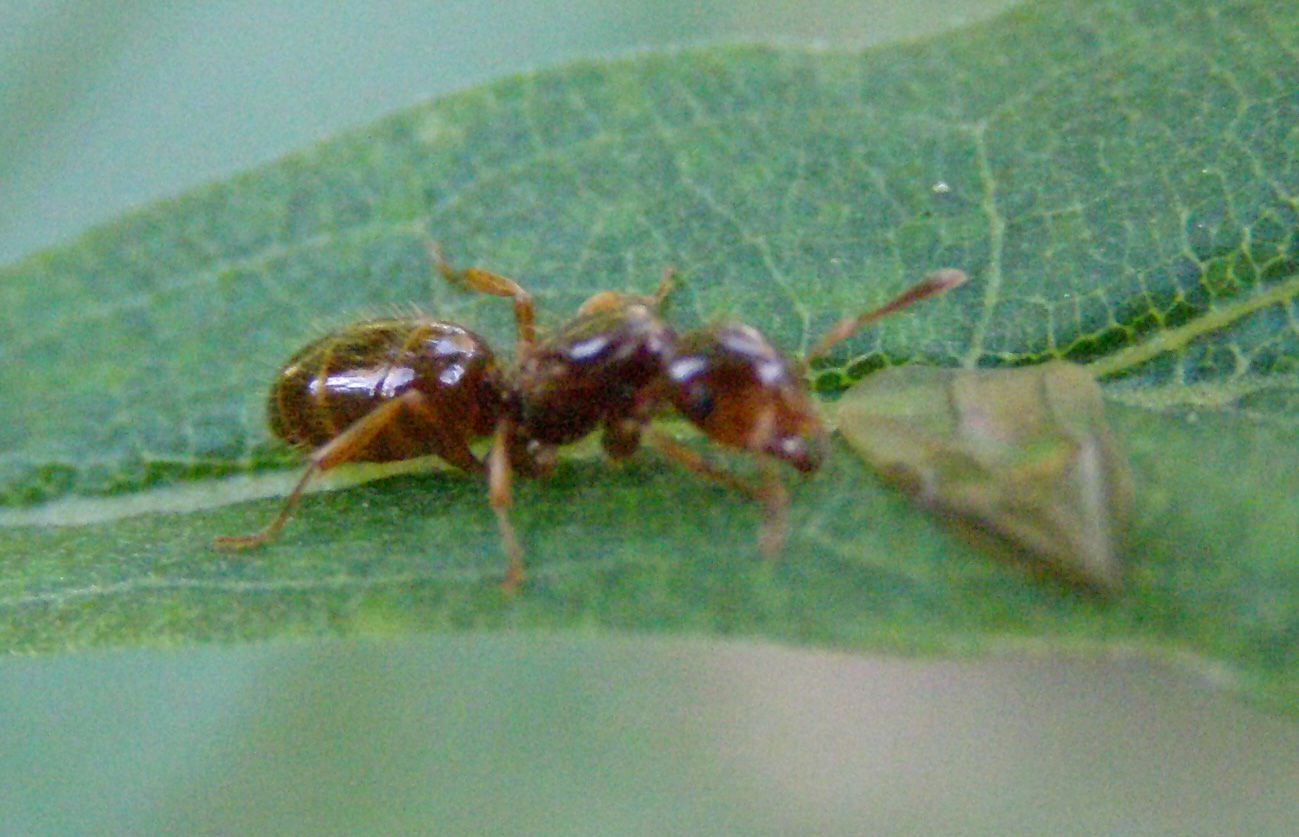
But really I would think it more beneficial to look for a host colony. Other queens on the ground immediately remove their wings after mating and scurry along to find a place to over winter or a host colony to parasatize.
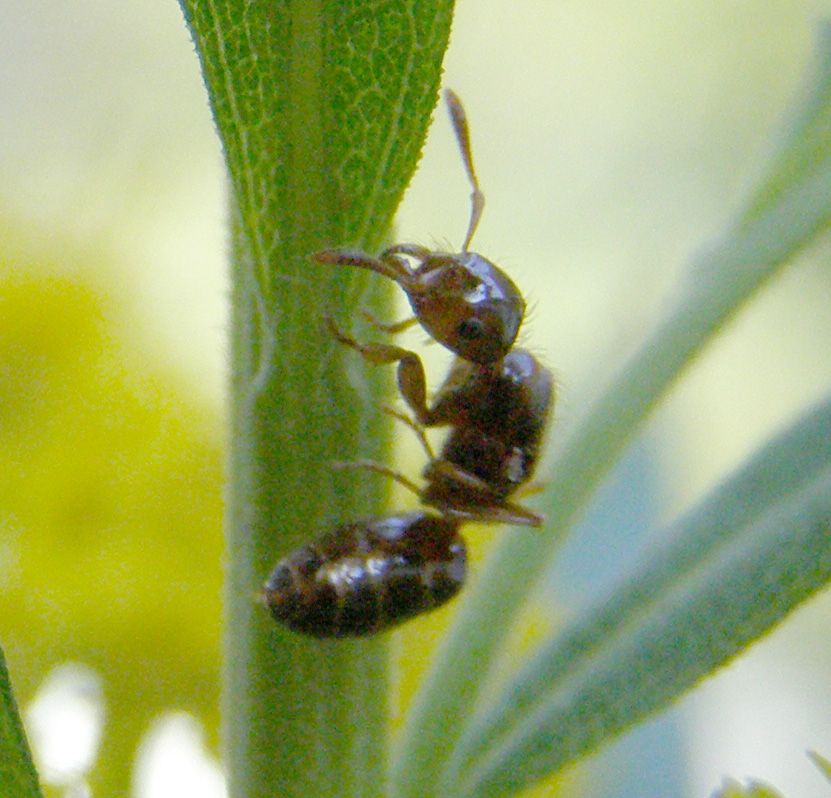
Along with Goldenrod I also see them on the Joe Pye Weed and Perennial Sunflower, all fairly tall plants. I didn't look much at the perennials but I imagen I could find some on them too.
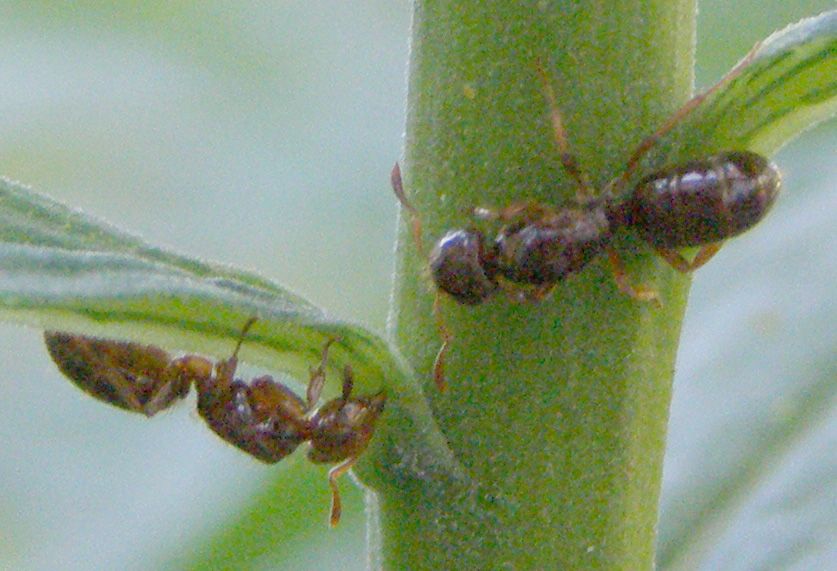
Even at night (not photoed) there were tons of these queens still motionless doing nothing. Ones that I did photo I'm reasonably sure still hadn't moved. I'll report back if it's just warming up, if they're still there tomorrow, and or if they start sprouting mushrooms.
Sunday, October 18, 2009
Insect Trap - Lost Land of the Volcano Highlight Episode 3 - BBC One
Over the Summer you can do that at home too but don't expect to get anywhere near as much diversity. All it takes is a white sheet illuminated with a light or black light at night. Having a clear view of the sky will also help.
Saturday, October 17, 2009
My Ants are Still Alive
As you may know from a few posts ago the house was gassed for fleas. Which had little if any effect, the dogs and cats are still loaded with them as are the couches they touch. Works great on stink bugs though! There's a mound of dead ones next to me just outside the window.
So I have this box behind me where all my ant colonies were for the year. The box was outside during the gassing so they shouldn't have been effected. I've been somewhat afraid to open it though. But a few hours ago I finally did and am happy to say everyone seems to be alive. I was afraid left over poison would eventually kill them. That doesn't seem to be happening. I don't think this stuff effects the digestive system or reproductive systems either. Even so I'm trying to minimize what they come in contact with.
Colonies:
Prenolepis imparis
Lasius neoniger
Lasius alienus
Camponotus castaneus
Myrmica sp. (caught her in spring but she finally laid eggs.... she has a fungus growing on her back too, but that's unrelated to the bombing.)
So I have this box behind me where all my ant colonies were for the year. The box was outside during the gassing so they shouldn't have been effected. I've been somewhat afraid to open it though. But a few hours ago I finally did and am happy to say everyone seems to be alive. I was afraid left over poison would eventually kill them. That doesn't seem to be happening. I don't think this stuff effects the digestive system or reproductive systems either. Even so I'm trying to minimize what they come in contact with.
Colonies:
Prenolepis imparis
Lasius neoniger
Lasius alienus
Camponotus castaneus
Myrmica sp. (caught her in spring but she finally laid eggs.... she has a fungus growing on her back too, but that's unrelated to the bombing.)
Friday, October 16, 2009
Guttation Drops Kill Honey Bees
Just got this from the beekeepers newsletter.
Guttation Drops Killing Honey Bees: Vincenzo Girolami, et. al., "Guttation Toxicity of Seedling From Coated Seeds, Journal of Economic Entomology, Volume 102, Number 5, October, 2009.
Guttation is a natural plant process where xylem fluid in a plant is excreted at the edge of the plants' leaves. In corn seedlings grown from seeds coated with neonicotinoids (systemic pesticides that are taken up by plants and expressed in nectar and pollen), the concentration of neonicotinoids in the guttation drops was found to be near those of the active ingredients in field sprays, or higher. Bees drinking these guttation drops died within minutes.
Guttation Drops Killing Honey Bees: Vincenzo Girolami, et. al., "Guttation Toxicity of Seedling From Coated Seeds, Journal of Economic Entomology, Volume 102, Number 5, October, 2009.
Guttation is a natural plant process where xylem fluid in a plant is excreted at the edge of the plants' leaves. In corn seedlings grown from seeds coated with neonicotinoids (systemic pesticides that are taken up by plants and expressed in nectar and pollen), the concentration of neonicotinoids in the guttation drops was found to be near those of the active ingredients in field sprays, or higher. Bees drinking these guttation drops died within minutes.
Wednesday, October 14, 2009
A Farm for the Future
This is part 1 of a 5 part documentary. I won't be posting the other parts but do give them a watch. It's a very interesting show.
Tuesday, October 13, 2009
KaBoom! :(
My parents surprised me today by saying "We're bombing the house." Naturally I was rolling my yes. Filling the house with a deadly poison is never a good idea. And my parents were trying to rush me out the door because they'd just started lighting off cans. I rushed to move EVERYTHING outside. All my test tubes, ant setups, even things I wasn't using. Miscellaneous tubbing, tweezers, magnifying glasses, all had to be removed and put outside.
I spent two hours out shopping at the mall and surveyed the damage when I got home. Stink bugs trying to get in the window that were alive before are now dead or dying. Those that are alive are now foaming at the mouth with spittle and moving in a confused way. These were insects just outside the window and they're now dead.
My parents did this after trying to rid our dog of flees. After coming home it wasn't long before I had one on me alive and well.
As much as I argued against this my parents wouldn't listen that it's not the right thing to do. My ant room is now completely contaminated and I'm afraid to use anything. All of my colonies are young and very susceptible to disease. I'll be bringing them inside later on tonight. For now though everything is airing out.
I spent two hours out shopping at the mall and surveyed the damage when I got home. Stink bugs trying to get in the window that were alive before are now dead or dying. Those that are alive are now foaming at the mouth with spittle and moving in a confused way. These were insects just outside the window and they're now dead.
My parents did this after trying to rid our dog of flees. After coming home it wasn't long before I had one on me alive and well.
As much as I argued against this my parents wouldn't listen that it's not the right thing to do. My ant room is now completely contaminated and I'm afraid to use anything. All of my colonies are young and very susceptible to disease. I'll be bringing them inside later on tonight. For now though everything is airing out.
Sunday, October 11, 2009
Lasius claviger have flown
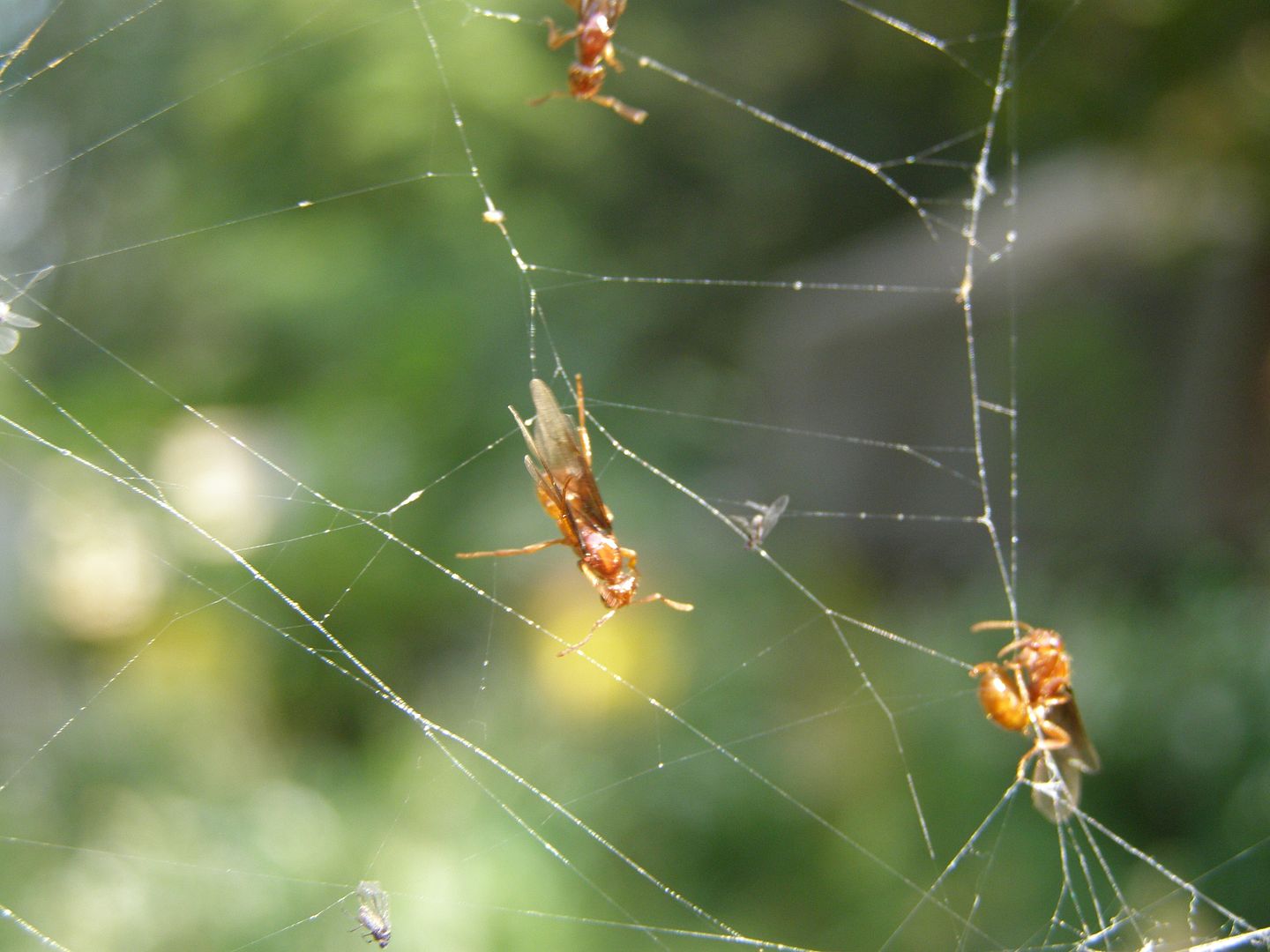
As I exited the home to plant a new garden I found a swarm of Lasius claviger exiting one of the many nests. This was the only colony in my yard bothering to fly and as you can see it wasn't very successful. One of our large garden spiders, the kind that make fantastically huge webs, had it's web filled with flying ants. I was on a bit eager to plant though, and this is a fairly common species so I was a little lazy to get a good shot.

The color on some of these queens is fantastic.
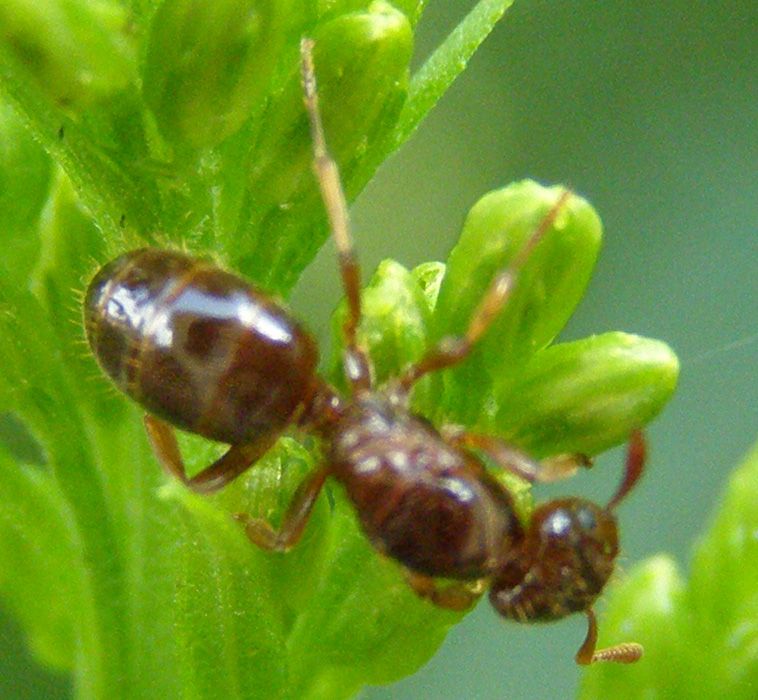
I say some because there is quite a range of varying color scheme among queens. I've seen pale yellow, bright orange, striking reds, a range of browns, and even black. The browns are usually the most common, and the yellows I suspect simply haven't developed yet. But red is fairly common in some colonies where in others only 1 in 100 queens will be red. This colony was interesting because it leaned towards the red side.

While taking a break I walked through the garden and found a lot of the darker queens had a liking for the goldenrod. I'm not sure what they were doing but nearly every cane had a queen on it. I don't bother catching this species because they're social parasites, and requires an established colony for them to take over.
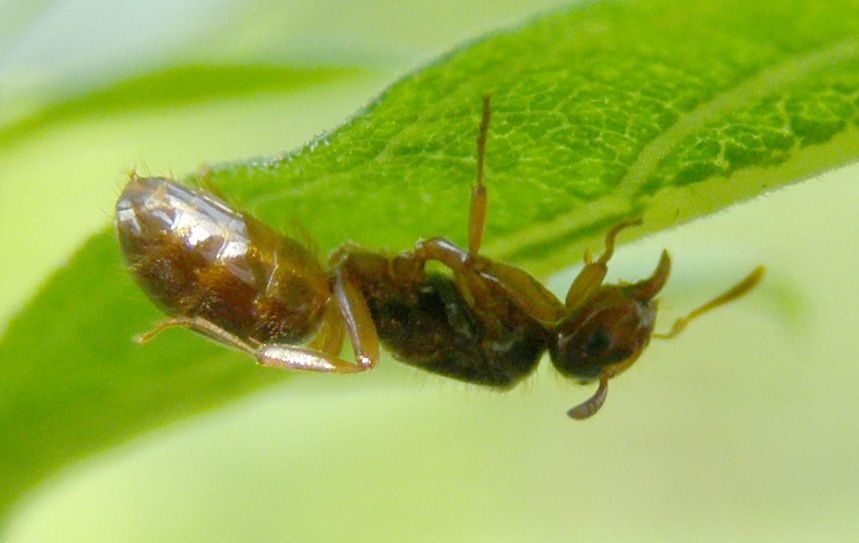
I can't help but wonder if there's some strategy with clinging to goldenrod plants. Maybe they over winter inside the stems?
Saturday, October 10, 2009
Ways to Save Money?
I just read one of those "lists" that the Internet passes off as a news article. It was 10 ways to save money. And the thing that got me was "Plant a Garden, you'll get a $500 return...."
HAHAHAHAH! Ok I'm not saying that this is false. You do generally get some return in food when planting a garden. But the full $500 return is after you've found out what varieties go great in your area, have successful pollination, (which varies dramatically from crop to crop,) and dealt with diseases and watering. Not to mention finding out if your soil is high in heavy metals or not which means you need to install raised beds if you want to eat anything.
$500 is such an arbitrary number too. I would say quite high for the average garden. If you have a yard/lawn that's nothing but full sun though you're probably in the best position to see a return.
HAHAHAHAH! Ok I'm not saying that this is false. You do generally get some return in food when planting a garden. But the full $500 return is after you've found out what varieties go great in your area, have successful pollination, (which varies dramatically from crop to crop,) and dealt with diseases and watering. Not to mention finding out if your soil is high in heavy metals or not which means you need to install raised beds if you want to eat anything.
$500 is such an arbitrary number too. I would say quite high for the average garden. If you have a yard/lawn that's nothing but full sun though you're probably in the best position to see a return.
Wednesday, October 7, 2009
Box of Goodies
This afternoon I found a rectangular shaped box on my doorstep. It looked like someone had sat on the thing, even though the word "Fragile" was scrolled across the side. Oh well. I opened it up and found plants that I'd ordered. Yay!
In this particular box were two Spice Bushes, Lindera benzoin, and a Goldenrod, (I'll find out the species at a later date.) Spice Bushes have two sexes and only the female plants produce berries but both are host to a fascination butterfly, the Spicebush Swallowtail, Papilio troilus. The caterpillar actually mimics a snake, right down to retractable red antenna that flicker like a snake does with it's tongue to taste the air.
Another great caterpillar to look out for on these plants is the Promethea Moth, Callosamia promethea. Though it is one of our Giant Silk Moths it's not the biggest. Still worth attracting though it is on the decline. A parasite introduced to deal with Gypsy Moths has taken a liking to this species unfortunate.
I'll post back with more plants I get in the mail. Everything should arrive by Friday and I hope to get them all in the ground by winter.
In this particular box were two Spice Bushes, Lindera benzoin, and a Goldenrod, (I'll find out the species at a later date.) Spice Bushes have two sexes and only the female plants produce berries but both are host to a fascination butterfly, the Spicebush Swallowtail, Papilio troilus. The caterpillar actually mimics a snake, right down to retractable red antenna that flicker like a snake does with it's tongue to taste the air.
Another great caterpillar to look out for on these plants is the Promethea Moth, Callosamia promethea. Though it is one of our Giant Silk Moths it's not the biggest. Still worth attracting though it is on the decline. A parasite introduced to deal with Gypsy Moths has taken a liking to this species unfortunate.
I'll post back with more plants I get in the mail. Everything should arrive by Friday and I hope to get them all in the ground by winter.
Giant Leopard Caterpillar
Today I found a Hypercompe scribonia caterpillar. They're the all black furry caterpillar people find now and mistake for the woolly bear caterpillar which has a brown stripe in in the middle. This one is also called the Giant Leopard Moth. What's neat about these is unlike the woolly bear caterpillar the Giant Leopard over winters and keeps growing in the spring. It's called a Giant because in the spring time the caterpillar can get pretty big, almost as long as your hand about. For now though they're maybe an inch or two long. Here's the BugGuide.net link for them.
I've taken pictures but don't know if they're usable yet.
I've taken pictures but don't know if they're usable yet.
Sunday, October 4, 2009
The Girl Who Silenced the World for 5 Minutes
What a horrible little girl. We should have children give speeches mentioning every problem the world is facing to the United Nations everyday. Imagen the headlines for just a minute. Ghetto Demolished to make way for New Forest. I'm no expert but I think that contradicts the arguments she makes about homeless and poor people being taken care of. It would have been nice to hear a plan of action from her rather then going down a list of problems with her essay.
Okay I'm being to harsh on her. I just don't like this attitude of demanding the government to take care of Everything. I wish these tasks were more community based so people would be more inspired to take part and directly pave a future for their children rather then pay their taxes for someone else to do it. Everyone in the US should be handed a copy of Bringing Nature Home: How You Can Sustain Wildlife with Native Plants, Updated and Expanded
Doug Tallamy summarizes these events beautiful, and has a clear, logical, flow of reasoning that lead to his conclusions and the actions he recommends. He explains in detail some great plants to start out with and how they're best planted. There are lists in the back of his book showing other options based on region and conditions; all of which are native. And there's even a lengthy chapter on the sorts of insect life you'll start seeing with emphases on Lepidoptera (moths and butterflies).
The girl in the video was very brave and spoke loudly though. I admire this but wish she were herd by a larger audience. Pay attention to the shots of the UN members and count the empty seats around them. I'm not entirely certain when this video was taken but look at the blurry focus. How could this be a video from 2008?
Friday, October 2, 2009
Things Butterflies can Teach Us
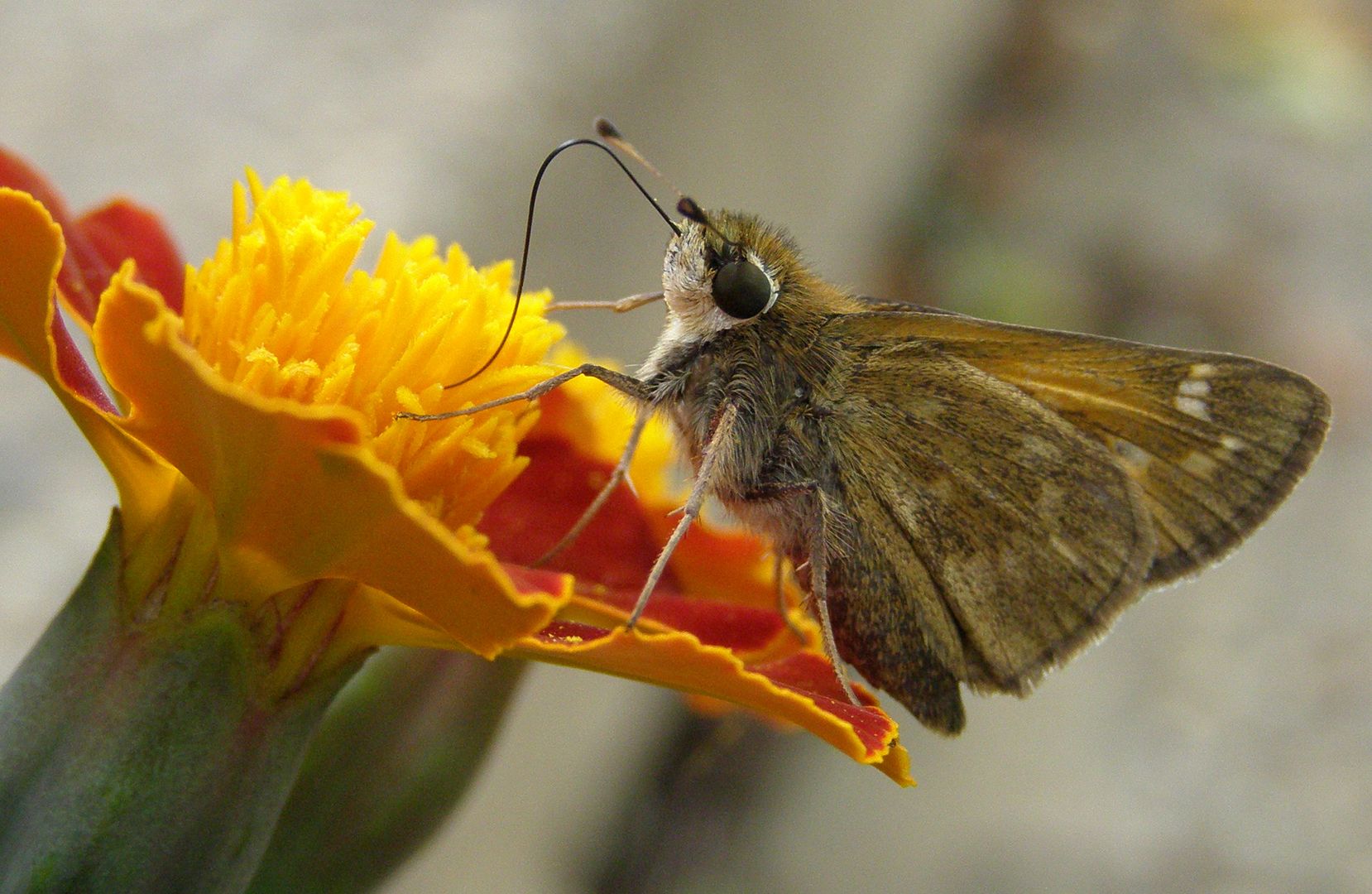
This skipper looks dressed for winter. I'm sure brightly colored flowers must look warm too. I'm looking at my Monarch pictures to keep warm right now. Burrrr.
Things I've learned from the butterflies:
1) stare at sun to keep warm. (disclaimer, do not stare at sun!)
2) cocoons will keep you warm.
3) migrating south for winter is the best idea ever.
4) plants are chewy.
5) eating milkweed will help you develop. (disclaimer, do not eat milkweed!)
Thursday, October 1, 2009
The Winter Ant
As Winter sets in plant life slowly dies back and focuses it's energy into growing roots rather then green growth. (I'm not sure what evergreens do but it can't be much.) As this food source dries up all the herbaceous insects go dormant. Butterflies and caterpillars all die back. Aphids lay eggs that over winter while the entire adult generation dies off. Protein foods don't store well over the winter so Ants are forced to focus more on carbohydrates.
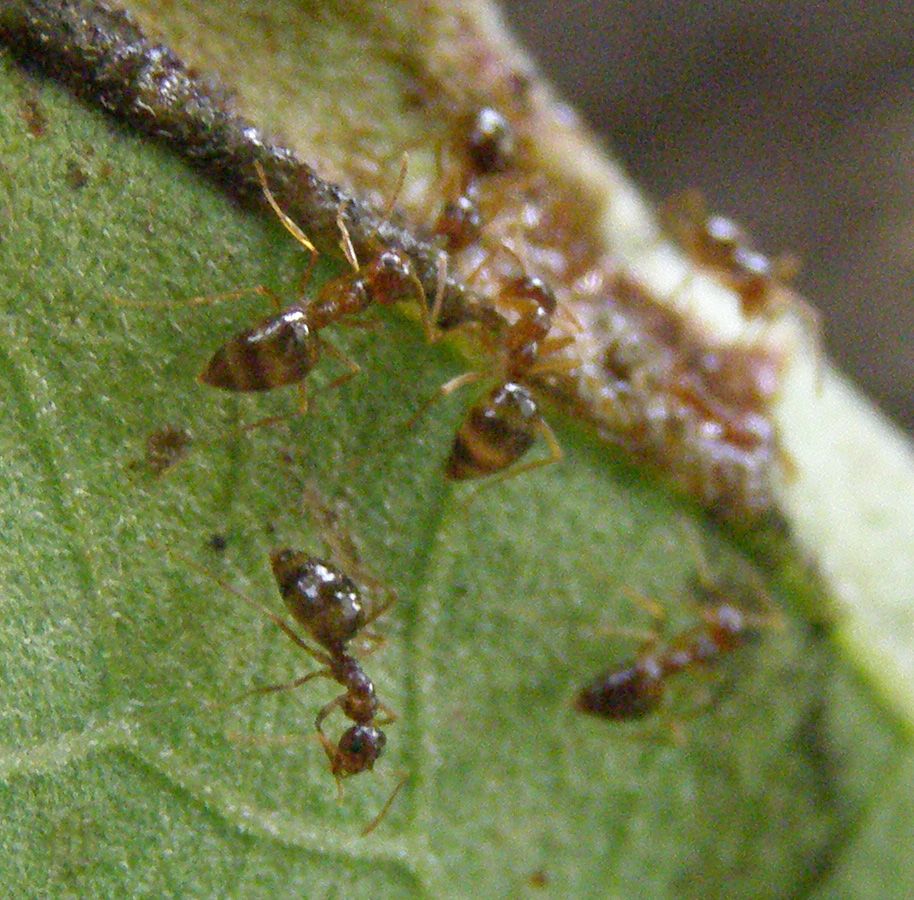
The Winter Ant, Prenolepis imparis, has the advantage when it comes to foraging in the Fall, Winter and Spring. Any day where it's above freezing out these ants are able to forage carefree. They can do this because every enzyme in their body is built to work in cold temperatures.

The food source at this time is usually tree sap. In this case damaged sunflowers. Colonies don't get horrible huge, maybe 12,000 ants. But their colonies can be abundant. Their ability to forage during the warmer parts of winter puts them on a whole different level. They go dormant over the summer when there's more competition for food. But during the winter they're likely the only species foraging.

The Pest Control industry has deemed them The Small Honey Ant or False Honey Ant. Treating colonies is easily done. But frankly why would you want to? They're not an indoor pest as far as I know. I have colonies all over my yard and have never seen so much as a worker wonder inside (that wasn't from a colony I had in captivity,) and they're don't do property damage. They can make a mound but it's not above the grass line. I could understand if your lawn was nothing but moss or a putting green but you really have to hate ants.
Look for their brightly colored queens on the first warm day or two of March and April in the late afternoon. (I've seen flights as early as February 11th but March is more common.)

The Winter Ant, Prenolepis imparis, has the advantage when it comes to foraging in the Fall, Winter and Spring. Any day where it's above freezing out these ants are able to forage carefree. They can do this because every enzyme in their body is built to work in cold temperatures.

The food source at this time is usually tree sap. In this case damaged sunflowers. Colonies don't get horrible huge, maybe 12,000 ants. But their colonies can be abundant. Their ability to forage during the warmer parts of winter puts them on a whole different level. They go dormant over the summer when there's more competition for food. But during the winter they're likely the only species foraging.

The Pest Control industry has deemed them The Small Honey Ant or False Honey Ant. Treating colonies is easily done. But frankly why would you want to? They're not an indoor pest as far as I know. I have colonies all over my yard and have never seen so much as a worker wonder inside (that wasn't from a colony I had in captivity,) and they're don't do property damage. They can make a mound but it's not above the grass line. I could understand if your lawn was nothing but moss or a putting green but you really have to hate ants.
Look for their brightly colored queens on the first warm day or two of March and April in the late afternoon. (I've seen flights as early as February 11th but March is more common.)
Labels:
Ants,
Cold,
Replete,
Sunflower,
Winter Ant
Subscribe to:
Posts (Atom)